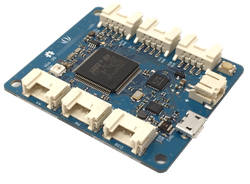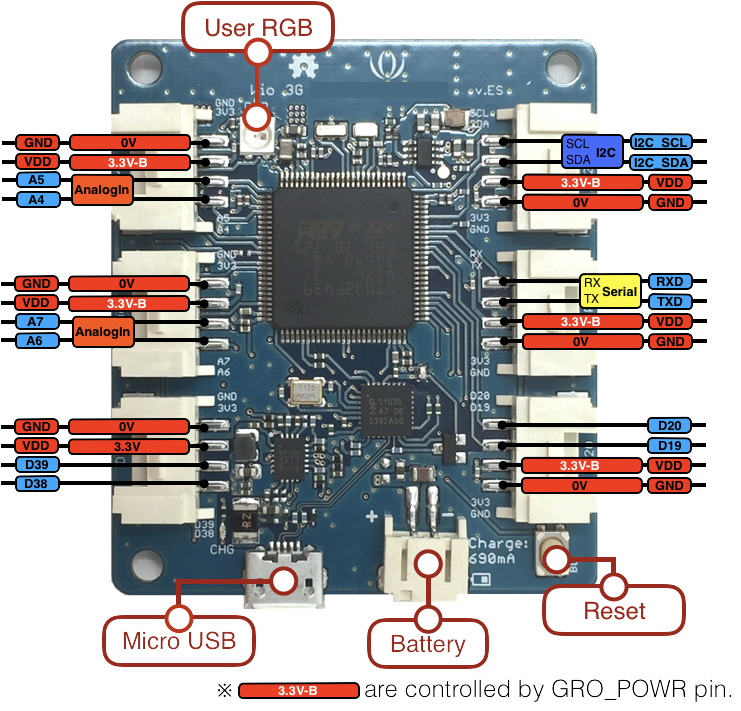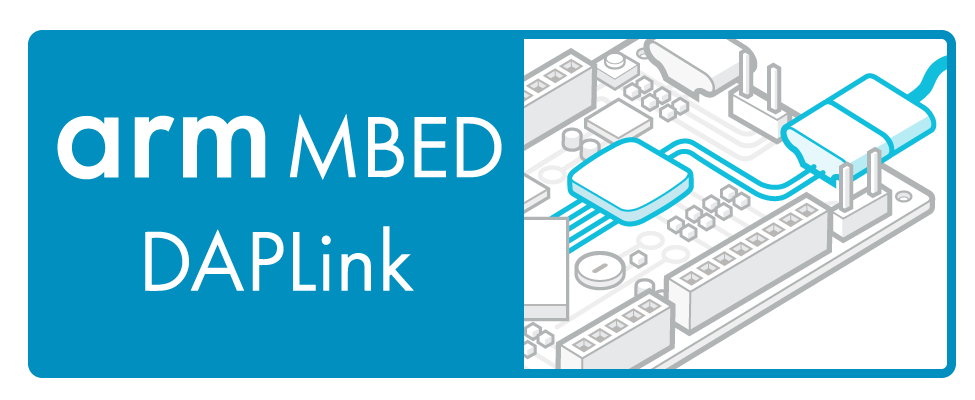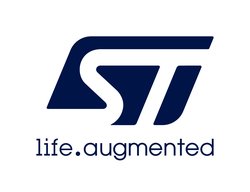Seeed Wio 3G
Wio 3G is a complete board that enables quick prototyping of a variety of applications for the cellular Internet of Things.

MCU¶
STMicroelectronics STM32F439VI
Arm® Cortex®-M4 core with DSP and FPU, 2 MBytes Flash, 256 KBytes SRAM
Cellular module¶
Quectel UG96
UMTS 800 / 850 / 900 / 1900 / 2100MHz
GSM/EDGE 850 / 900 /1800 / 1900MHz
Pinout¶

Wio 3G have 6x Grove System connector. It is compatible with 3.3V interface grove modules. Some Grove modules were registered on Components. For non Grove peripherals, you can connect easily with "Grove to 4pin Female/Male Jumper" cables.
To turn-on 3.3V power supply to "3.3V-B" pins, please make power control pin HIGH like below.
DigitalOut GrovePower(GRO_POWR, 1);
On-board peripherals¶
RGB LED:
DigitalOut LEDPower(RGB_POWR, 1);
Sample code: https://os.mbed.com/teams/Seeed/code/Wio-example-blinky/
The LED on this board is SK6812MINI, intelligent LED chip. The control data pin is PB_1.
SD:
DigitalOut SDPower(PA_15, 1);
Sample code: https://os.mbed.com/teams/Seeed/code/Wio-example-sd-driver/
And the SPI pins connected to SD slot are MOSI: PC_12, MISO: PC_11, SCK: PC_10, CS: PD_0 as defined on sample code.
The instructions to install/remove SD/SIM cards are here. https://seeedjp.github.io/Wiki/General/how_to_sim_tf-en
Known issues¶
- CTS/RTS connection is swapped from MCU native pin definition on ES version hardware. This causes a problem with Mbed OS 5.11. - Workaround
- Wio 3G (UG96) always failed to run at the 2nd connection - This problem will be resolved in a future release.
Solved:
- PB_7 (RXD) cannot be used for Serial - Solved on release 5.11.4.
Interface¶
- 6x Grove connector (3.3V I/O)
- 2x Digital I/O
- 2x Analog Input ( can be used as Digital I/O )
- 1x UART ( can be used as Digital I/O )
- 1x I²C ( can be used as Digital I/O )
- Cellular antenna U.FL connector
- nano SIM card slot ( optional eSIM )
- DAPLink ( USB Micro-B connector )
- Li-Ion battery connector ( JST PH, charging current 690mA )
- Micro SD card slot
Microcontroller features¶
- STM32F439VI in LQFP100 package
- ARM®32-bit Cortex®-M4 CPU with FPU Adaptive real-time accelerator (ART Accelerator™) allowing 0-wait state execution from Flash memory
- 180 MHz max CPU frequency
- 2 MB Flash
- 256 KB SRAM
- TRNG (True random generator)
- Cryptographic acceleration: hardware acceleration for AES 128, 192, 256, Triple DES, HASH (MD5, SHA-1, SHA-2), and HMAC
- Up to 17 timers
- 3x SPI
- 3x I2C
- 4x USART
- 1x SAI (Serial Audio Interface)
- 3x 12-bit ADC
- 2x 12-bit DAC
Battery Operation¶
Wio 3G includes a MP2617B monolithic switch mode battery charger with power path management for single-cell Li-ion batteries. The charge current is set by a resistor attached to the ISET pin on the MP2617B. The 3K Ohm resistor installed by default sets the charge current at 690mA which is tolerable for most typical batteries with a capacity greater than or equal to 690mAH. Please consult the MP2617B datasheet and the datasheet for your battery to ensure compatibility. The connector is JST PH, since there is no standard to use this connector for Li-Ion batteries, please take care about the polar.
The "CHG" LED next to Micro USB receptacle indicates battery charging status.
| LED Statues | Battery Statues |
|---|---|
| Blinking | No battery or error |
| ON | Charging |
| OFF | Charging complete |
Firmware Update¶
The latest Arm Mbed DAPLink interface firmware is available at (click the image):
Pre-installed DAPLink interface firmware is wio_3g_interface_v251_20181110.bin
To check your firmware version and built date, open the MBED.HTM or DETAILS.TXT of your MBED disk in a text editor.
To update the firmware,
- Hold the reset button and power on it
- A CRP DISABLD disk will show
- On Windows, replace firmware.bin with the above firmware
- On Linux/Mac, use command: dd if={new_firmware.bin} of={firmware.bin} conv=notrunc
Resources¶
You need to log in to post a discussion


